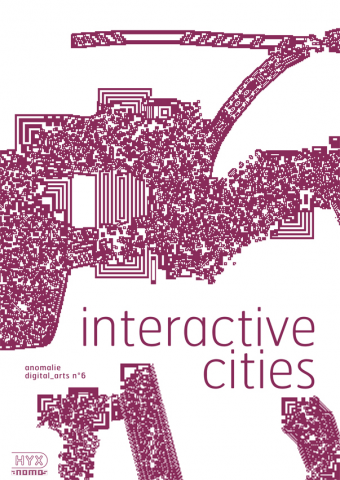
Anomalie_digital art n°6
Interactive Cities
The review is edited by architect and urban planner Valérie Châtelet who, as part of anomos/skylab, has been exploring the far-reaching repercussions of digital technologies. The essays are illustrated by numerous architectural and urban projects, in large part unpublished and presented here for the first time. Historians, geographers, engineers, artists, architects and urban planners examine the implications of our novel urban condition...
Abstract
In the field of urban planning, there has been much debate about the information and intelligence society and its flourishing potential. Discussion is gradually veering away from the idea of modeling all the components involved in a given project, as a means of managing the complexity of sustainable development. Instead, current initiatives call on continuous, distributed and dynamic methods to ensure consistency among the environmental, economic and social dimensions. Interactive Cities contributes to this debate with over a dozen articles by various recognized authors. The review is edited by architect and urban planner Valérie Châtelet who, as part of anomos/skylab, has been exploring the far-reaching repercussions of digital technologies. The essays are illustrated by numerous architectural and urban projects, in large part unpublished and presented here for the first time. Historians, geographers, engineers, artists, architects and urban planners examine the implications of our novel urban condition. Among the contributors, Dominique Rouillard offers an historical perspective of how information and communication technologies have been integrated in urban planning. In reference to the work of American inventor Buckminster Fuller, Valérie Châtelet discusses the concept of new decision-making processes for regional and urban planning. Carlo Ratti and Daniel Berry of MIT's SENSEable City research lab explore how wireless internet connections and mobile telecommunications create mobile landscapes that are reconfiguring our way of life.
Technology pervades today's cities. "It is everywhere: security cameras around the corners, in stores and offices, sensors and actuators automatically open doors of department stores, the fiberoptical lines underneath our streets, and the wireless network in the air." (J. Huang; M. Waldvogel). Distinctions between daily life, work and leisure time are increasingly blurred, generating new ways of using space that are managed on nearly a real-time basis (G. Schmitt; C. Ratti; D. Berry). Cell phones and portable devices have facilitated the emergence of new collaborative methods for creating and maintaining the public commons (J. Huang; M. Waldvogel; V. Chatelet). With the improved capabilities for calculation and the ever-growing digital realm, enables us "to contemplate processing spatial data including a large number of diverse spatial interactions," to simulate "the spatial evolution of cities" and "to explore possible futures" (D. Pumain). Finally, the development of innovative design tools, along with enhanced geographic information systems and project development strategies, are reshaping practices (V. Châtelet; L. Perrin; D. Gerber; G. Schmitt).
Informations
- 25,00 €
- Language(s): English, French
- Référence:978-2-910385-42-2
- Nombre de pages: 248
- Couleur(s): quadrichromie
- Type de reliure: broché
- Dimensions: 1 × 17 × 24 cm
- Poids: 800 g
